Interested in taking a dip in the Kanawha River? If so, you may be wondering what critters live in and around this waterway and if it’s safe to swim in.
In this guide, we’ll cover what’s in the Kanawha River from potential pollution to some species who call this river and the surrounding lands home. We’ll also discuss what risks swimmers may face.
Read on to learn more.
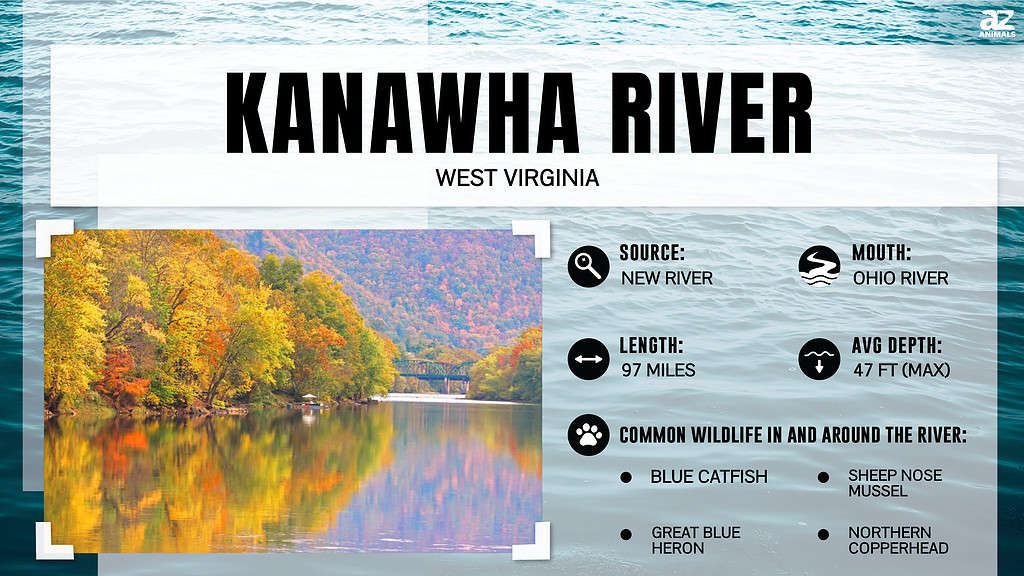
Overview of the Kanawha River
A tributary of the Ohio River, the Kanawha River is 97 miles long. It is the largest inland waterway in West Virginia. The headwaters of this river form at the confluence of the New River and Gauley River near the town of Gauley Bridge, West Virginia.
This Appalachian river flows 97 miles northwest before joining the Ohio River in the town of Point Pleasant, West Virginia.
Climate and Geography
Lush mountain forests, rolling hills, and vast plateaus border the Kanawha River. It gently weaves its way through the Appalachian Mountain range. The Kanawha River Valley exists within a humid subtropical climate, featuring hot, humid summers and rainy, cold winters. The waters of the Kanawha are a pleasant temperature for summer swimming. It is extremely rare for any portion of the river to freeze during the winter.
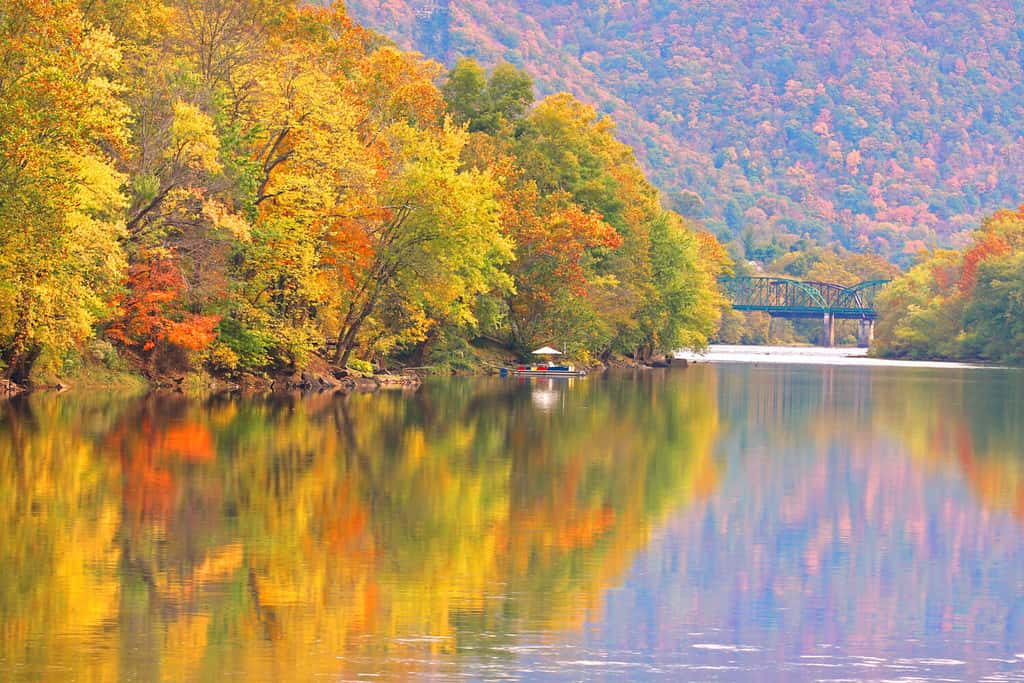
Situated within the Appalachian region, the Kanawha River is often bordered by stunning mountains.
©SNEHIT PHOTO/Shutterstock.com
Pollution Threats
The ecosystem of the Kanawha River, much like the broader regions of Central Appalachia, is vastly diverse. Unfortunately, pollution from various extractive industries along the river threatens the delicate ecosystem of the Kanawha. For decades, chemical plants, coal mining, and extraction of natural gas, oil, and mineral deposits along the river have caused extension pollution of the Kanawha River. This waterway is a part of 2,000 miles of streams and rivers across West Virginia negatively impacted by one of the toxic effects of coal mining in Appalachia- acid mine drainage (AMD).
While restoration and cleanup efforts of the river span from individuals to large non-profit organizations and the EPA has improved water quality, the Kanawha River is still negatively impacted to this day by current operations and over a century of pollutive extraction and processing plants.
What’s in the Kanawha River: Dioxin Contamination
One example of the long-term effects of extraction on the river is the high levels of dioxin researchers have found in the river’s sediment. This contamination is particularly prevalent in a 14-mile stretch of the Kanawha River that begins at the meeting of the Kanawha and Coal Rivers. According to the EPA, the consumption of fish contaminated by dioxin is one of the most significant human health risks associated with fishing in the Kanawha River. Dioxin is a highly toxic chemical produced as a byproduct of certain manufacturing processes. In this case, the EPA suspects the dioxin contamination of the Kanawha River is largely due to pesticide production by the Pharmacia/Monsanto Company from 1948-1969. In 2017, the EPA found extensive cleanup plans still necessary for this stretch of the Kanawha River.
Despite the pollution impacts, thanks to intensive restoration efforts, often by regular folks, and the adaptability and hardiness of a range of species, life still exists in this gentle river.
Critters of the Kanawha River
An array of animal life exists in and around the Kanawha River. Insects, reptiles, birds, and amphibians all call this waterway home. Below, we’ll discuss the following four species of animals that call the Kanawha River home:
- Blue catfish
- Sheep nose mussel
- Great blue heron
- Northern copperhead
What’s in the Kanawha River: Blue Catfish (Ictalurus furcatus)
Belonging to the Ictaluridae family, the blue catfish (Ictalurus furcatus) is the largest species of North American catfish. The Kanawha River is no stranger to these large, predatory fish. Anglers have repeatedly caught state-record-breaking blue catfish from the Kanawha River. The current West Virginia record belongs to an angler who hauled in a 67.22 lb, 50.7 inch-long blue catfish caught in the waters of the Kanawha.
Blue catfish are the apex, generalist predators of this river. They feed on a variety of smaller fish species, crustaceans, mollusks, amphibians, reptiles, insects, and plants. They even feed on other blue catfish.
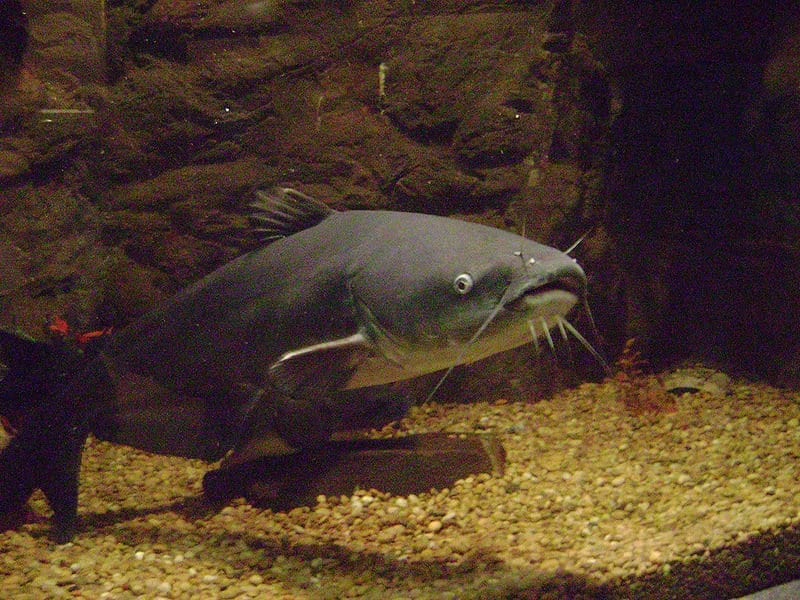
The blue catfish of the Kanawha River are opportunistic, apex predators.
©Billy Ogle/Flickr – License
Sheep Nose Mussel (Plethobasus cyphus)
A member of the mussel family, Unionidae, the sheep nose mussel (Plethobasus cyphus) is a federally endangered mollusk. A range of activities impacts this endangered mussel such as damming, channelization, and dredging.
You can find this mussel in shallow, coarse-sandy areas with moderate to swift currents. There, they feed by filtering organic matter such as zooplankton and phytoplankton from the water and sediments on the river floor. For much of their lives, sheep-nose mussels live partially or entirely buried in the sandy river bottom.
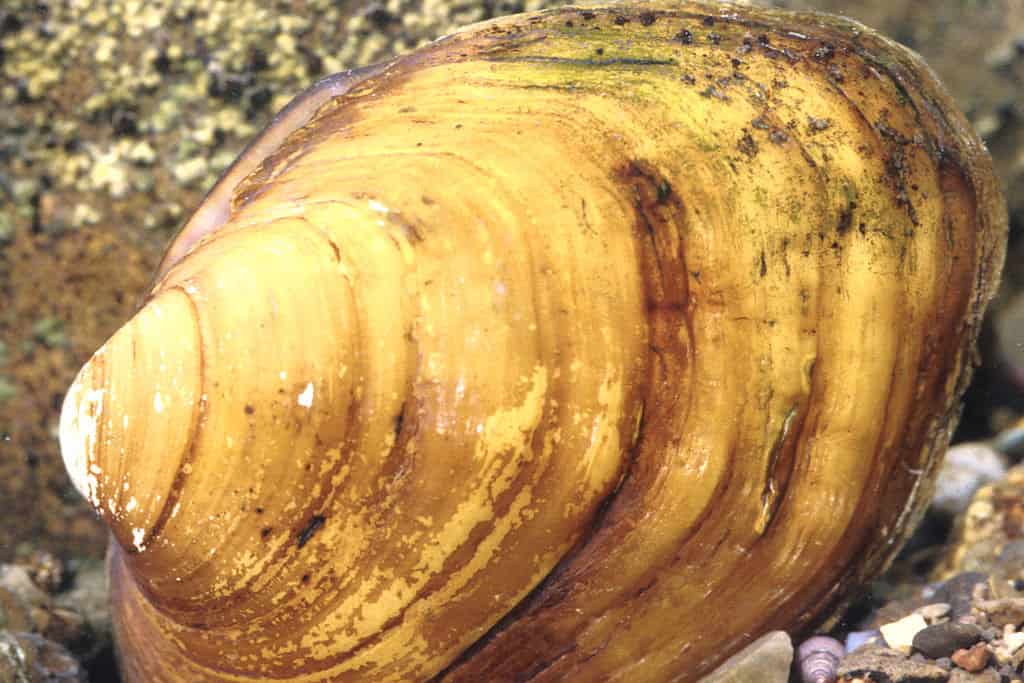
The sheep nose mussel is a federally endangered mollusk whose range includes the Kanawha River.
©Dick Biggins, U.S. Fish and Wildlife Service, Public domain, via Wikimedia Commons – License
What’s in the Kanawha River: Great Blue Heron (Ardea herodias)
If you visit the Kanawha River, you may have the pleasure of seeing a great blue heron (Ardea herodias) wading in the shallows or flying across the river in search of food. These large, graceful birds can reach up to 4.5 feet tall with up to a 7-foot wingspan. Despite their imposing size, adults only weigh up to 6 pounds due to their hollow bones.
These birds mainly prey on fish. However, they are quite adaptable and can eat other animals. They enjoy snakes, insects, rodents, and turtles when fish are scarce. On the Kanawha River, you may spot a great blue heron hunting for a variety of fish such as smallmouth bass, walleyes, and sunfish.
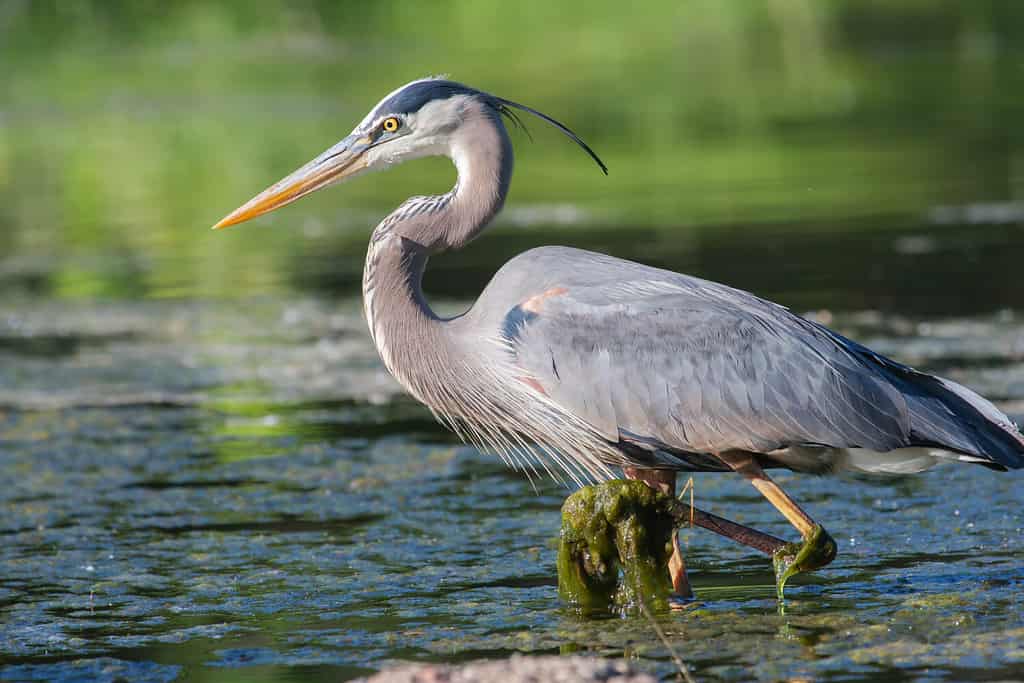
If you’re lucky, you may spot a great blue heron wading in or flying above the waters of the Kanawha.
©Joseph Scott Photography/Shutterstock.com
Northern Copperhead (Agkistrodon contortrix mokasen)
The banks and bordering forests of the Kanawha River serve as prime habitats for several snake species, including the northern copperhead (Agkistrodon contortrix mokasen). This gorgeous snake is one of two venomous species you can find in West Virginia.
Like other copperheads, the northern copperhead features a gold-colored eye with an elliptical, vertically-oriented black pupil. The head of this species is unmarked and copper-colored. As a pit viper, the northern copperhead has a triangular-shaped head. The body color is reddish-copper and features chestnut brown hourglass-like banding. This horizontal hourglass banding narrows toward the spine and widens towards the sides of the snake.
Despite an unwarranted reputation as aggressive, the northern copperhead does not go out of its way to chase or attack people. Instead, its camouflaging leads to unfortunate encounters. People accidentally step on or get far too close to the snake without noticing its presence.
Practice careful observation if you hang out on the banks of the Kanawha. Make special notes in areas with wood piles and tall grass. This habitat is great for sheltering the northern copperhead. It also provides a great hunting ground for preying on mice, small birds, lizards, amphibians, insects, and even other small snakes.
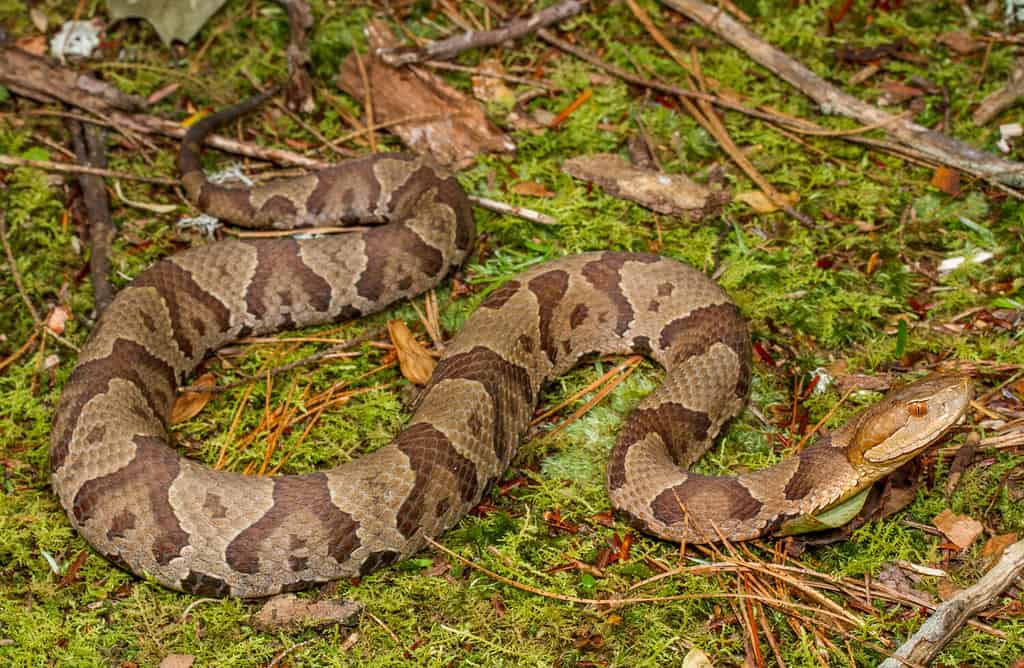
The northern copperhead is one of two venomous snakes whose range includes West Virginia. To avoid accidentally getting close to or stepping on this lovely snake, be observant in areas along the banks of the Kanawha, especially where the grass is high or there are wood piles.
©JacobLoyacano/Shutterstock.com
Is It Safe to Swim in the Kanawha River?
Overall, the water currents of the Kanawha are fairly gentle. The species you may find in and around this river which likely poses the biggest threat to people is the northern copperhead. It won’t chase or otherwise seek out a confrontation with humans.
However, the pollution history is varied and significant in stretches of the river leading to superfund site designation by the EPA. There are warnings about the consumption of some species of fish. Overwhelmingly, practices by greedy people and companies over the last 400 years have posed the most dangers to people interacting with the Kanawha River. From settler colonial violence against indigenous tribes to pollutive resource extraction and industrial practices along the river. In the past 20 years especially, restorative practices and restrictions on company pollution have helped improve the health of this river’s ecosystem.
Ultimately, there are likely more remote areas of the Kanawha River that are lovely to swim in. They pose far less of a safety risk than areas of the river near industrial centers like Charleston.
The photo featured at the top of this post is © canonball photography/Shutterstock.com
Thank you for reading! Have some feedback for us? Contact the AZ Animals editorial team.







